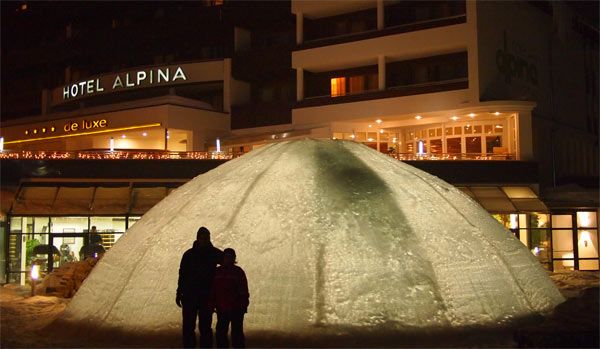In Austria, Imbibe in the New Ice Dome

Kiddy igloos grow up in the latest engineering feat in Austria, where a huge ice dome has been erected and now serves as a bar —as long as temperatures stay chill enough.
The dome structure , which sits in front of a hotel in the village of Obergurgl and was completed last Monday (Jan. 27), has a 33-foot (10 meters) free span, or stretch supported solely by the outside walls.
Using ice as a building material has actually been done before: Entire ice hotels have been built, for instance, in Scandinavia.
"In most cases, though, the spans of the structures are small or the ice is not a load-bearing component and merely acts as cladding for the actual construction," said researcher Johann Kollegger of Vienna University of Technology.
In Japan, ice domes have been built using a construction method in which water is sprayed onto a balloon. Kollegger thinks his team's new method is easier — for instance, when spraying water onto the balloon, the ice sprays back at the workers.
To build their freestanding structure, Kollegger and his colleagues first cut an 8-inch- thick (20 centimeters) plate of ice into 16 segments. To sculpt the segments to have dome-like curve, the researchers relied on ice's creep behavior. If pressure is applied to ice, it slowly changes its shape without breaking. One of the mechanisms by which glaciers move, called glacial creep, functions similarly, the researchers say.
"The segments of ice are placed on stacks of wood. Then, under the load of its own weight, the ice begins to change shape all by itself, resulting in a curved dome segment," said team member Sonja Dallinger, research assistant at the Institute of Structural Engineering and on-site manager of the Obergurgl construction experiment.
Sign up for the Live Science daily newsletter now
Get the world’s most fascinating discoveries delivered straight to your inbox.
The greatest challenge the team faced was preventing the individual curved segments from breaking while being assembled into the dome. To keep the pieces intact, the team built a wooden tower at the dome's center to support the pieces during construction. The segments were held together with steel chains. Once all the segments had been positioned and the ice dome stood on its own, the team removed the tower.
The completed structure has been open for more than a week for use by the hotel as a bar.
Any heat? Kollegger said the icy bar feels warmer than reality because the air is so still inside and ice serves as an insulating material.
As for how long the bar will be open, Kollegger said that even if temperatures climb above freezing, the ice dome would still persist. In order to change water into ice, it takes a lot of energy and that same amount of energy is needed for the reverse phase change – from ice to water. That's why when you take an ice cube out of the freezer the ice doesn't melt right away.
"More dangerous than the heat is solar radiation, the energy from the sun," Kollegger told LiveScience.
Kollegger thinks the dome will probably last until March or so, when it will start showing signs of deterioration from solar radiation.
Their goal is really to create bigger and better temporary ice structures, he said during a telephone interview.
You can follow LiveScience managing editor Jeanna Bryner on Twitter @jeannabryner.
Jeanna Bryner is managing editor of Scientific American. Previously she was editor in chief of Live Science and, prior to that, an editor at Scholastic's Science World magazine. Bryner has an English degree from Salisbury University, a master's degree in biogeochemistry and environmental sciences from the University of Maryland and a graduate science journalism degree from New York University. She has worked as a biologist in Florida, where she monitored wetlands and did field surveys for endangered species, including the gorgeous Florida Scrub Jay. She also received an ocean sciences journalism fellowship from the Woods Hole Oceanographic Institution. She is a firm believer that science is for everyone and that just about everything can be viewed through the lens of science.
